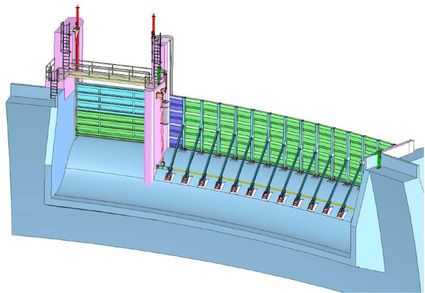Swan Lake expansion on track for 2016

Submitted Illustration
A graphic representation of the Swan Lake dam spillway after the flashboards and vertical gate are installed, seen from downstream. The spillway is 105 feet across at the crest and 14 feet deep, while the new water path will be 23 feet across for the vertical gate. Spanning 78 feet, the flashboards collapse by design to protect the dam's integrity during extremely large flood events.
This year's planned expansion of one of its primary hydropower facilities weighed high on the list of priorities for Southeast Alaska Power Agency's governing board when it met in Wrangell late last week.
SEAPA CEO Trey Acteson reported most of the major bids had been awarded for components of the Swan Lake dam expansion, a $10 million project which will increase active storage by 25 percent and yield between 6,000 and 12,000 Megawatt hours annually.
A civil, mechanical and electrical engineering contract was signed with McMillen/Jacobs last June, and a request for bids was issued Feb. 1 for civil construction. An award date is scheduled for March 15. A contract for flashboard system fabrication was signed with Austrian firm Kuenz America in November, with components due by July 31. Last month a contract was also awarded to Kuenz for the new vertical gate, due by the same date.
The flashboard system fabrication will span 78 lineal feet, 17 feet tall, and is designed to collapse in the event of a flood scenario. The vertical gate, shipped in halves, together spans 23 feet across and weighs 20 tons.
Acteson explained the project is continuing on schedule, with the expected completion of construction and assembly of the gates and flashboards by the end of September. Commissioning is to finish by October, and project closeout finalized by the end of December.
The expansion project will offset around 500,000 gallons of diesel fuel each year, and no rate increase is anticipated. Just less than two-fifths of the project costs are to be grant-funded, and member communities approved up to $7 million in bond sales last spring to cover the rest.

In his report to the board, Acteson explained the project required significant time and resources on the part of SEAPA staff, putting together bid specifications and completing contracts on the flashboards and gates.
"A lot of hours." Acteson said. "We're really getting to the point where we're digging into the details."
Once bid documents are returned by mid-March, Acteson told board members to be prepared for a special meeting to approve a contract for civil construction.
For the duration of the expansion project, Acteson explained SEAPA will make use of a 5 MW "load bank" to minimize spillover during the work. Water levels will be kept low throughout the expansion for the safety of workers on-site, which the load bank helps with by drawing additional load and burning off excess storage in the process.
The device will not be cheap – Acteson is seeking estimates, but he told board members it could be in the ballpark of a couple hundred thousand dollars.
During the meeting, held in Wrangell's Nolan Center Feb. 11 and 12, Acteson also updated board members on governmental activities at the state and federal level.
"There are a lot of things going on," Acteson prefaced in his report. "But they're all important issues that are very expensive to the agency."
In the United States Senate, the Energy Policy Modernization Act is currently back in committee. The piece of legislation is a federal omnibus bill concerning energy policy, and Acteson figured it would be the first substantive change to energy policy at the federal level in eight years.
Through an amendment to the act, SEAPA is attempting to correct a surveying error at the Swan Lake site with the cooperation of the Bureau of Land Management. If passed, about 26 acres of property that ought to have been transferred to SEAPA would be conveyed.
Also at the federal level, in November the United States Forest Service released its draft amendment to the Tongass Land and Resource Management Plan and Draft Environmental Impact Statement, triggering a 90-day public review and comment period. Though energy interests were represented in the Tongass Advisory Committee which helped inform the drafting process, from a utility standpoint Acteson was critical of the final product.
"I've been pretty frustrated with what's come out," he told SEAPA's board.
Though around 1,400 pages long, Acteson pointed out the draft only briefly addressed renewable energy development, and that its reclassification of the previous energy land use designation would make new projects more difficult to pursue.
"It's just really vague," he said.
Acteson informed the board SEAPA would submit comments ahead of a Feb. 22 deadline, seeking further clarity in the section outlining a renewable energy direction. Once a comment is submitted, it also leaves room for SEAPA at the table later on in the adoption process.
"Hopefully we'll get some positive change on that," Acteson said.
On the state level, Acteson reported staff were closely monitoring bills as the Legislature attempts to balance the budget. As a co-chair on the Alaska Power Commission, he participated in a legislative fly-in last month, meeting with legislators and Gov. Bill Walker.
In other business, at Wrangell's request SEAPA agreed to help fund a needed substation upgrade. The agency will put up half the cost for the project, or around $90,000. In addition to phasing out the aging H-structure overhead of the substation, Wrangell Municipal Light and Power superintendent
Clay Hammer explained the whole system will get an overhaul.
"That's Wrangell's connection to SEAPA right there," Hammer said. "Every ounce of power that comes into town has to come through that structure."
The infrastructure will be reinstalled underground, with four new pad-mounted switches added and capacity for additional load.
"It's going to make it a whole lot safer," Hammer said.
He was hopeful his crew would break ground by late May and make the switch by June, coinciding with the low load window between winter heating and fish processing.



Reader Comments(0)